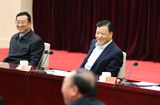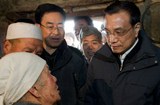The PLA Navy (PLAN) is China's mainstay for operations at sea, and is responsible for safeguarding its maritime security and maintaining its sovereignty over its territorial seas along with its maritime rights and interests. The PLAN is composed of the submarine, surface vessel, naval aviation, marine corps and coastal defense arms. In line with the requirements of its offshore defense strategy, the PLAN endeavors to accelerate the modernization of its forces for comprehensive offshore operations, develop advanced submarines, destroyers and frigates, and improve integrated electronic and information systems. Furthermore, it develops blue-water capabilities of conducting mobile operations, carrying out international cooperation, and countering non-traditional security threats, and enhances its capabilities of strategic deterrence and counterattack. Currently, the PLAN has a total strength of 235,000 officers and men, and commands three fleets, namely, the Beihai Fleet, the Donghai Fleet and the Nanhai Fleet. Each fleet has fleet aviation headquarters, support bases, flotillas and maritime garrison commands, as well as aviation divisions and marine brigades. In September 2012, China's first aircraft carrier Liaoning was commissioned into the PLAN. China's development of an aircraft carrier has a profound impact on building a strong PLAN and safeguarding maritime security.
The PLA Air Force (PLAAF) is China's mainstay for air operations, responsible for its territorial air security and maintaining a stable air defense posture nationwide. It is primarily composed of aviation, ground air defense, radar, airborne and electronic countermeasures (ECM) arms. In line with the strategic requirements of conducting both offensive and defensive operations, the PLAAF is strengthening the development of a combat force structure that focuses on reconnaissance and early warning, air strike, air and missile defense, and strategic projection. It is developing such advanced weaponry and equipment as new-generation fighters and new-type ground-to-air missiles and radar systems, improving its early warning, command and communications networks, and raising its strategic early warning, strategic deterrence and long-distance air strike capabilities. The PLAAF now has a total strength of 398,000 officers and men, and an air command in each of the seven Military Area Commands (MACs) of Shenyang, Beijing, Lanzhou, Jinan, Nanjing, Guangzhou and Chengdu. In addition, it commands one airborne corps. Under each air command are bases, aviation divisions (brigades), ground-to-air missile divisions (brigades), radar brigades and other units.
The PLA Second Artillery Force (PLASAF) is a core force for China's strategic deterrence. It is mainly composed of nuclear and conventional missile forces and operational support units, primarily responsible for deterring other countries from using nuclear weapons against China, and carrying out nuclear counterattacks and precision strikes with conventional missiles. Following the principle of building a lean and effective force, the PLASAF is striving to push forward its informationization transform, relying on scientific and technological progress to boost independent innovations in weaponry and equipment, modernizing current equipment selectively by applying mature technology, enhancing the safety, reliability and effectiveness of its missiles, improving its force structure of having both nuclear and conventional missiles, strengthening its rapid reaction, effective penetration, precision strike, damage infliction, protection and survivability capabilities. The PLASAF capabilities of strategic deterrence, nuclear counterattack and conventional precision strike are being steadily elevated. The PLASAF has under its command missile bases, training bases, specialized support units, academies and research institutions. It has a series of "Dong Feng" ballistic missiles and "Chang Jian" cruise missiles.
In peacetime, the PAPF's main tasks include performing guard duties, dealing with emergencies, combating terrorism and participating in and supporting national economic development. In wartime, it is tasked with assisting the PLA in defensive operations. Based on the national information infrastructure, the PAPF has built a three-level comprehensive information network from PAPF general headquarters down to squadrons. It develops task-oriented weaponry and equipment and conducts scenario-based training so as to improve its guard-duty, emergency-response and counter-terrorism capabilities. The PAPF is composed of the internal security force and other specialized forces. The internal security force is composed of contingents at the level of province (autonomous region or municipality directly under the central government) and mobile divisions. Specialized PAPF forces include those guarding gold mines, forests, hydroelectric projects and transportation facilities. The border public security, firefighting and security guard forces are also components of the PAPF.
The militia is an armed organization composed of the people not released from their regular work. As an assistant and backup force of the PLA, the militia is tasked with participating in the socialist modernization drive, performing combat readiness support and defensive operations, helping maintain social order and participating in emergency rescue and disaster relief operations. The militia focuses on optimizing its size and structure, improving its weaponry and equipment, and pushing forward reforms in training so as to enhance its capabilities of supporting diversified military operations, of which the core is to win local wars in informationized conditions. The militia falls into two categories: primary and general. The primary militia has emergency response detachments; supporting detachments such as joint air defense, intelligence, reconnaissance, communications support, engineering rush-repair, transportation and equipment repair; and reserve units for combat, logistics and equipment support.
teed by formulating and revising relevant laws, regulations and policies, and the armed forces are administered strictly by rules and regulations.
 |  |

 分享到人人
分享到人人 分享到QQ空间
分享到QQ空间














 回访和习近平握手渔民
回访和习近平握手渔民















